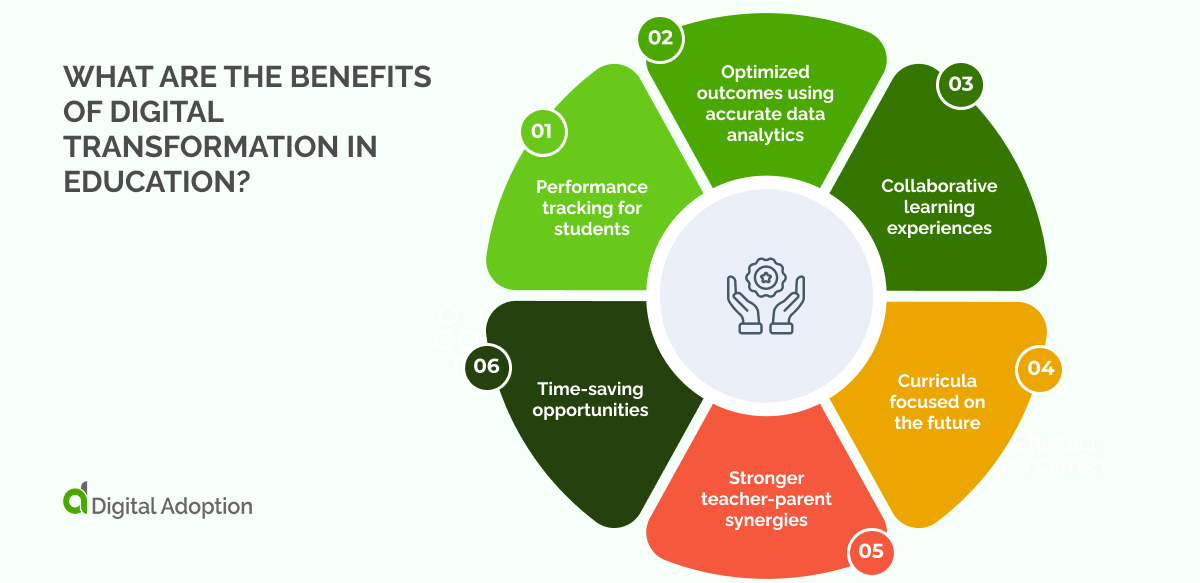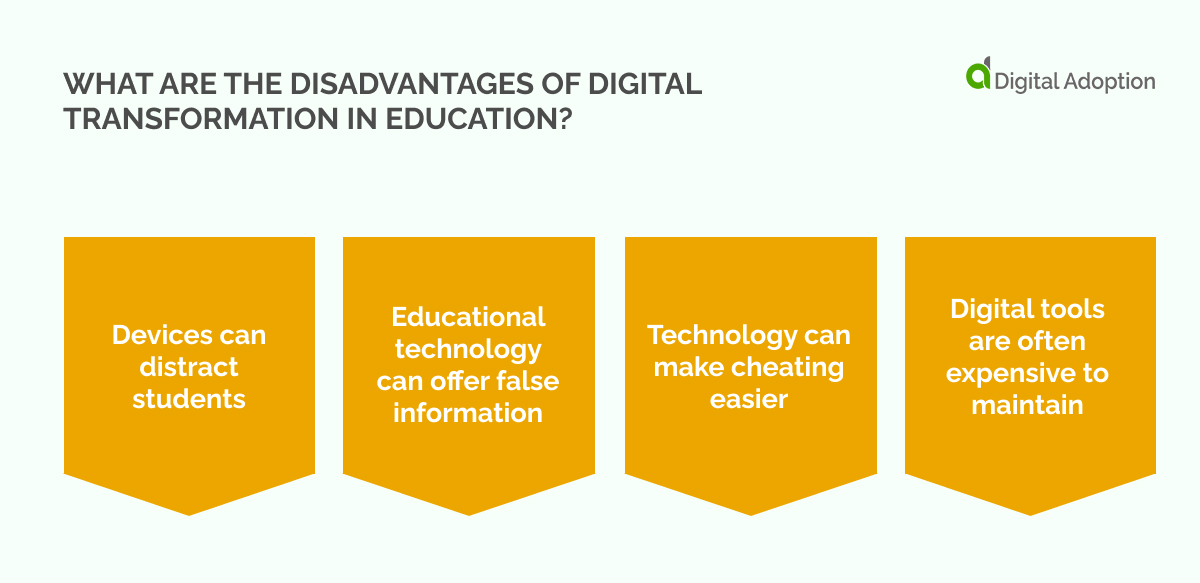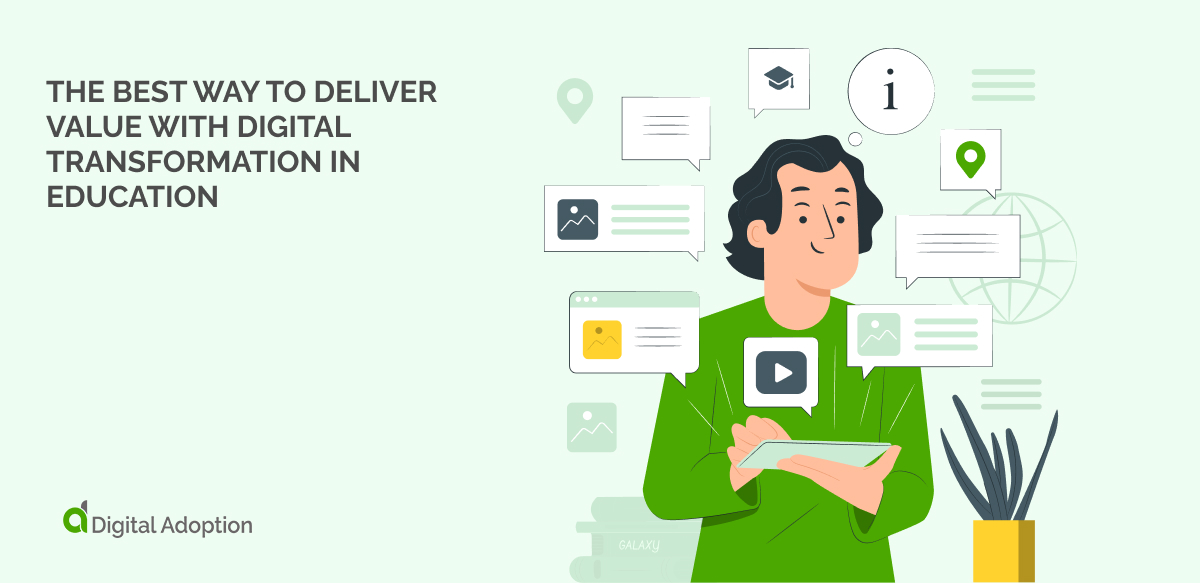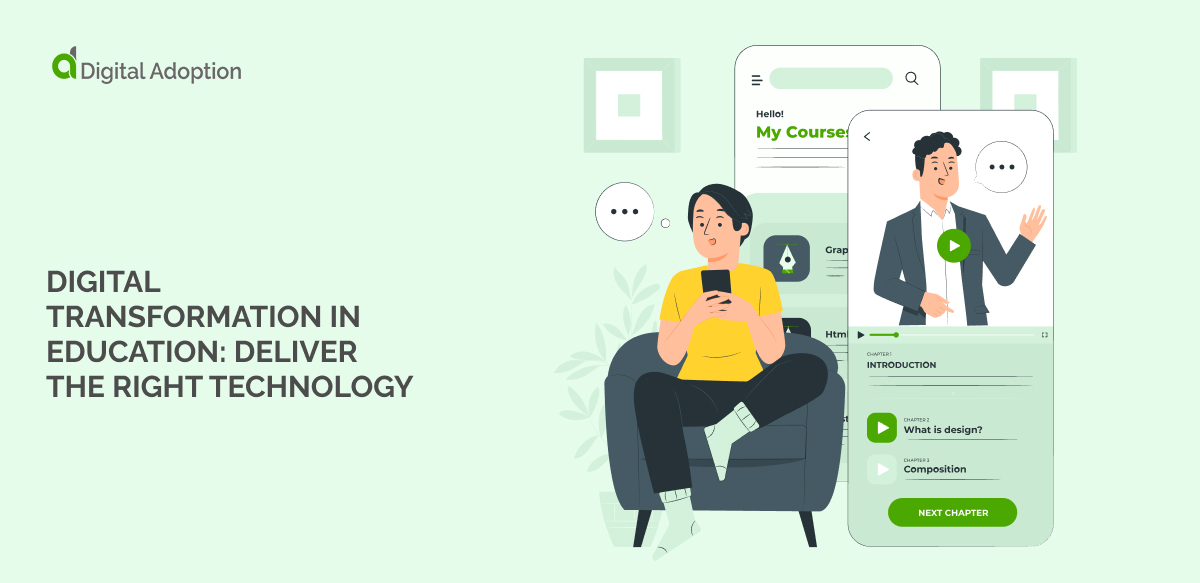How do you feel about technology adoption in education?
Do modern technologies like online classes and VR promote efficient, faster learning at the cost of communication? And does the cost of educational technology maintenance justify the investment?
Digital transformation in education can often feel like a double-edged sword. EdTech (educational technology) can provide many benefits for learners while delaying critical basic learning processes and skills such as creativity and attention span.
Whatever your view, investment in digital transformation in education is increasing, as the EdTech market will hit USD 404 billion by 2025.
Because of this increased investment, it is best to consider how your students might benefit from technology before you invest to extract the highest value.
To help you understand the basics and significance of digital transformation in education, we will explore the following topics:
- What is digital transformation in education?
- Why is digital transformation in education important?
- What are the benefits of digital transformation in education?
- What are the disadvantages of digital transformation in education?
- Best strategies for digital transformation in education
- What is digital transformation in education in 2023?
- Why is digital transformation in education important?
- What are the benefits of digital transformation in education?
- What are the disadvantages of digital transformation in education?
- The best way to deliver value with digital transformation in education
- Balance technology with human values in digital transformation for education
What is digital transformation in education in 2023?
Education 4.0 – transforming the future of education (through advanced technology)
Digital transformation in education is enhancing teaching and learning delivery using technology to improve effectiveness and efficiency, supporting student progression, and enhancing the quality of teaching methods like online learning.
Digital technology solutions have become essential in improving the overall student experience in 2023. Integrating digital technologies to augment personalized learning has become the standard way to support students in an increasingly digital world.
Why is digital transformation in education important?
Due to increased weather crises, conflicts, and the unprecedented explosion of technological innovation, digital technology has become a crucial tool to provide education as a fundamental human right in the US and the developing world.
Inefficient ICT infrastructure and poorly resourced digital learning systems caused countries’ most significant disruptions to education and learning losses during the COVID-19 pandemic.
As a result, up to one-third of students worldwide could not access learning for over a year due to school closures.
The COVID-19 pandemic highlighted the need for technology and human resources to work together to transform school models and create inclusive, open, and resilient learning systems.
UNESCO advocates for digital innovation to improve access to education and promote inclusion.
This process includes enhancing the quality of learning, developing lifelong learning pathways with the help of information technology, reinforcing education and learning management systems, and monitoring learning processes.
UNESCO aims to promote digital literacy and competency among teachers and students through their K-12 AI curricula. The curricula teach how to ethically and usefully incorporate AI into the learning process, and you can apply it to any educational organization.
What are the benefits of digital transformation in education?

Like many technology applications, digital transformation in education has several benefits, most involving collecting data on students and using it to help them develop and excel academically.
Performance tracking for students
Technology in the education sector can help teachers and parents keep track of students’ progress more efficiently. By digitizing things like students’ handwriting and creative work, educators can compare them to see who is improving and who may need extra help.
Doing so can lead to a better understanding of each student’s performance.
Optimized outcomes using accurate data analytics
Schools and universities can analyze data collected through students’ use of technology in the classroom to track performance and improve outcomes.
Doing so can help educators better understand the specific needs of individual students and classrooms.
Data analysis is not a substitute for teachers’ professional expertise, but it offers them a helpful resource.
Collaborative learning experiences
Collaboration is made more accessible by digital learning. Teachers can conveniently create and manage groups using learning platforms.
Collaborative authoring environments, such as Google Docs, Twiddla, and Edmodo, make it effortless for teams (whether near or far) to co-author documents and presentations.
These collaborative tools and augmented and virtual reality are already in use in organizations; therefore, why not teach students how to use them effectively before entering the workforce?
Curricula focused on the future
Schools must include future-oriented subjects in their curriculum, such as robotics, artificial intelligence, and automation.
These fields are no longer just fictional concepts but are becoming increasingly relevant in the workforce. However, current institutions may not feel prepared to teach these subjects.
Development and updating of the curriculum will now be faster, as students will have relevant and frequently updated content. Effortless updating means access to up-to-date material and features regularly.
Stronger teacher-parent synergies
When parents are engaged in their children’s academic progress, their children tend to excel in school and experience better overall health.
Automation enables the electronic delivery of progress and attendance reports to parents and prompts them to pay their child’s fees promptly.
Maintaining transparency among all parties enhances the relationship between parents and teachers.
Time-saving opportunities
A digitalization transformation can save time in today’s fast-paced world, where time is money. However, many cities besides metros lack a fully developed transport system. As a result, students may have to spend several hours commuting to reach their educational institutions.
In this scenario, students from even the remotest parts of the country can benefit from a digital course.
Through the efforts of UNISA and GetSmarter, students from around the world can learn via a website or dish TV channel instead of spending time and effort commuting from one location to another.
What are the disadvantages of digital transformation in education?

An academic study shows many disadvantages to digital transformation in education if educational organizations don’t utilize technologies correctly, such as negatively impacting students’ attention spans and consuming large portions of the academic day.
There are also other disadvantages to digital transformation efforts in education.
Devices can distract students
Children and adults equally enjoy being mentally stimulated by electronic devices. While educational devices can support many learning applications, the experience of using them can become habitual and distract from the actual process of learning, posing one of several digital transformation risks in education.
Educational technology can offer false information
Educational technology like ChatGPT and other LLMs (large language models) often contains biases and false information that can damage the delicate learning process as students develop their attitudes to fields of knowledge and other people.
Technology can make cheating easier
As we have seen from using generative AI tools like ChatGPT by students, technology can make cheating much easier for learners as they can use it to write their essays.
Doing so is enabled by accessing information that skips the learning process and allows them to present information as if they had researched it themselves, negatively impacting the learning process.
Digital tools are often expensive to maintain
Educational budgets, particularly for publicly funded schools, are already stretched, and digital educational tools can push them further without a clear vision of what the heads of the schools want to utilize them for.
This scenario can lead to low-value, a high-cost budget deficit which can quickly impact the quality of students’ education in other areas.
The best way to deliver value with digital transformation in education

The best way to provide value to your students with digital transformation in education involves several factors, all of which SWOT analysis covers as it enables personalized learning approaches as you define the scope of digital transformation in education for your organization.
A SWOT analysis (Strengths, Weaknesses, Opportunities, and Threats) ensures accuracy and a successful digital transformation in education.
This method will help you as an educational institution meet your requirements and have a more defined plan for future actions as you ensure investment provides value for your students.
Educators and administrators can utilize a SWOT analysis within education digital transformation to:
- Consider where your school/university is acting most effectively.
- Pinpoint helpful directions and areas requiring improvement.
- Identify strategic goals to work towards.
- Examine the viability of digital initiatives.
- Define how stakeholders will benefit from the transformation.
- Explore how to implement new tools throughout the educational process.
Following your SWOT analysis, as part of your steps to achieve a complete digital transformation of educational processes, hiring a dependable technology partner to manage technology implementation and provide a high-performing solution is crucial.
Balance technology with human values in digital transformation for education
As digital technologies continue to advance rapidly, there is no doubt that education and its many associated activities will see digital transformation in the next few years.
With countless potential opportunities that come with digital transformation for education, effective implementation of such solutions should include long-term planning, cost-benefit analysis, security considerations, and robust user acceptance testing – all while trying to balance digital innovation with human values.
It’s best to use the power of digital transformation for education with significant consideration as it promises to bring educational success and allow for innovations today students can only imagine but can also impose limitations on learning.





![18 Examples of AI in Finance [2025]](https://www.digital-adoption.com/wp-content/uploads/2025/06/18-Examples-of-AI-in-Finance-2025-300x146.jpg)
![14 Examples of AI in Manufacturing [2025]](https://www.digital-adoption.com/wp-content/uploads/2025/06/14-Examples-of-AI-in-Manufacturing-2025-300x146.jpg)
![29 Examples of AI in Education [2025]](https://www.digital-adoption.com/wp-content/uploads/2025/06/29-Examples-of-AI-in-Education-2025-300x146.jpg)
![15 Examples of AI in Retail [2025]](https://www.digital-adoption.com/wp-content/uploads/2025/06/15-Examples-of-AI-in-Retail-2025-300x146.jpg)



![18 Examples of AI in Finance [2025]](https://www.digital-adoption.com/wp-content/uploads/2025/06/18-Examples-of-AI-in-Finance-2025.jpg)
![14 Examples of AI in Manufacturing [2025]](https://www.digital-adoption.com/wp-content/uploads/2025/06/14-Examples-of-AI-in-Manufacturing-2025.jpg)